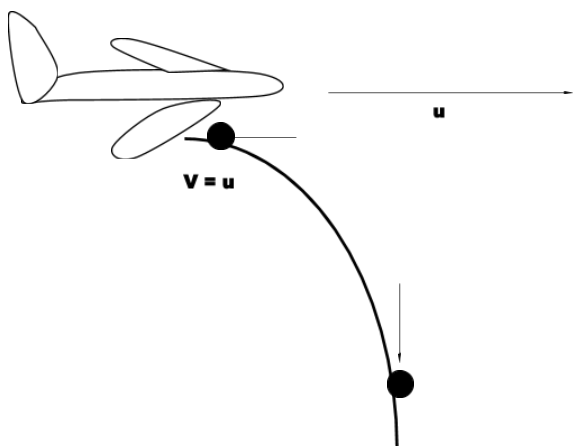
A bomb is released by a horizontal flying aeroplane. What is the trajectory of the bomb?
A.Parabola
B.Straight line
C.Circle
D.Hyperbola
Answer
566.1k+ views
Hint: An object in rest in a moving object tends to keep the motion if the object is separated during the motion due to the Inertia of motion. Also, any object is subject to gravitational force and thus accelerates vertically downwards, given that it is at a height above the surface.
Complete answer:
Let us consider ‘u’ as the horizontal velocity in which the aeroplane is moving with the bomb. At the instant of releasing the bomb from the plane, by virtue of its motion, the bomb also possesses the initial velocity ‘u’.

Now, as we know the cause of the motion of the bomb was the motion of aeroplane which is no longer holding it. At the time of release the bomb moves in the horizontal direction (with zero vertical velocity) as that of the plane. Eventually, it loses its ability to move forward as there exists no cause for horizontal motion. But, according to Newton’s first law of motion – Everybody tends to be in its state of rest or uniform motion unless it is experienced by an external force. So, there should be an external force which causes the bomb to lose its horizontal velocity and it is the frictional force caused by the air. The vertical gravitational force which was not affecting the bomb while in the aeroplane becomes the strong force on it now. As a result, the bomb starts to acquire vertical acceleration (with zero horizontal velocity).
From our observations we can conclude that the bomb when released continues its horizontal velocity for sometimes, then gets vertically accelerated due to gravitational force. We can say that the bomb traces a parabolic path.
The answer is given by option A.
Additional Information:
Initially the bomb has only the horizontal (cosine) component of motion. Eventually it turns out that it possesses only vertical (sine) components. Meanwhile, there is a time when it possesses both cosine and sine components, this contributes to the parabolic phase of motion.
Note:
A projectile motion is a motion which is similar to the one given here. The difference is that for a projectile there is an angle between the vertical and horizontal components at the initial stage other than at right angles, whereas this problem turns out to have 90 degrees to the vertical component initially.
Complete answer:
Let us consider ‘u’ as the horizontal velocity in which the aeroplane is moving with the bomb. At the instant of releasing the bomb from the plane, by virtue of its motion, the bomb also possesses the initial velocity ‘u’.

Now, as we know the cause of the motion of the bomb was the motion of aeroplane which is no longer holding it. At the time of release the bomb moves in the horizontal direction (with zero vertical velocity) as that of the plane. Eventually, it loses its ability to move forward as there exists no cause for horizontal motion. But, according to Newton’s first law of motion – Everybody tends to be in its state of rest or uniform motion unless it is experienced by an external force. So, there should be an external force which causes the bomb to lose its horizontal velocity and it is the frictional force caused by the air. The vertical gravitational force which was not affecting the bomb while in the aeroplane becomes the strong force on it now. As a result, the bomb starts to acquire vertical acceleration (with zero horizontal velocity).
From our observations we can conclude that the bomb when released continues its horizontal velocity for sometimes, then gets vertically accelerated due to gravitational force. We can say that the bomb traces a parabolic path.
The answer is given by option A.
Additional Information:
Initially the bomb has only the horizontal (cosine) component of motion. Eventually it turns out that it possesses only vertical (sine) components. Meanwhile, there is a time when it possesses both cosine and sine components, this contributes to the parabolic phase of motion.
Note:
A projectile motion is a motion which is similar to the one given here. The difference is that for a projectile there is an angle between the vertical and horizontal components at the initial stage other than at right angles, whereas this problem turns out to have 90 degrees to the vertical component initially.
Recently Updated Pages
Master Class 12 Business Studies: Engaging Questions & Answers for Success

Master Class 12 Economics: Engaging Questions & Answers for Success

Master Class 12 English: Engaging Questions & Answers for Success

Master Class 12 Maths: Engaging Questions & Answers for Success

Master Class 12 Social Science: Engaging Questions & Answers for Success

Master Class 12 Chemistry: Engaging Questions & Answers for Success

Trending doubts
What is meant by exothermic and endothermic reactions class 11 chemistry CBSE

Which animal has three hearts class 11 biology CBSE

10 examples of friction in our daily life

One Metric ton is equal to kg A 10000 B 1000 C 100 class 11 physics CBSE

1 Quintal is equal to a 110 kg b 10 kg c 100kg d 1000 class 11 physics CBSE

Difference Between Prokaryotic Cells and Eukaryotic Cells




